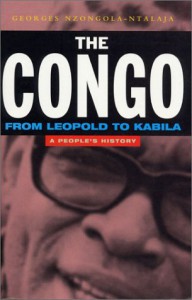Currently reading
Middlemarch: An Authoritative Text, Backgrounds, Reviews and Criticism (A Norton Critical Edition)
The Magic Mountain
Love in the Time of Cholera
 If this is the worst book that I read in 2013, it'll be a very good year.
If this is the worst book that I read in 2013, it'll be a very good year.Very much a people's history, but more in the original tradition of Morton's [b:People's History of England|449190|A People's History of England|Arthur Leslie Morton|http://d.gr-assets.com/books/1347992838s/449190.jpg|437840], with broad strokes regarding class relations, social forces, conflicting ideologies, imperialist power, and so on (there's even mention on occasion of dialectics and contradiction, so, yaknow, overtly marxist), rather than the more colloquial and personal demarginalization of resistance voices that one might find in Zinn's [b:People's History of the United States|2767|A People's History of the United States 1492 to Present|Howard Zinn|http://d.gr-assets.com/books/1348900509s/2767.jpg|2185591]. The distinction is that the former presents the establishment version of history from the perspective of critique, along with an authoritative, centralizing narrative of resistance tendencies, whereas the latter is pleased to decentralize the narration, forefronting the counter-narrative in fragmented form through the direct discourse of contemporary interlocutors. Both traditions have their respective values. Those conversant with marxist theory will note oblique references to Althusser, quotations of Gramsci, and citations to Poulantzas; explicit references to Herr Marx appear--but the analysis is dominated, appropriately, by Fanon & Cabral.
Writer is Congolese, in on the ground floor with the decolonization and resistance movements described. Despite the passionate attachment of the author, the writing is sober. The book is familiar with Horschild, and seems generally supportive of that work.
Chronicles the initial seizure of the Congo by the Belgian monarch, who ruled it as a personal possession, rather than under the auspices of the Belgian state. The death toll for the 23-year period of personal rule is ten million human persons, attributable to market mechanisms and the behavior of concessionaire corporations from around the capitalist world. The first state to recognize Leopold's claim, incidentally, was the United States in 1884 (Chester Arthur FTW!), prior to the Berlin Conference of 1885, which resulted informally in the cementing of the claim (16).
Thereafter the volume presents the neocolonial situation, then Mobutu's crazed tenure, and then the post-Mobutu rule of poppa Kabila and the commencement of baby Kabila's reign. The post-Mobutu period is characterized by the Congo wars (perhaps too quickly presented, and somewhat bewildering), which resulted in the deaths of over 5 million persons. The surplus extraction of Congolese labor was sufficient for Belgium to fund its participation in both world wars: during its stay in London in WW2, e.g., the Belgian government in exile did not borrow any moneys and did not deplete its gold reserves, even while funding its military and diplomatic corps (29).
At each of the four stages of Congolese history, Nzongola-Ntalaya is careful to examine the opposition: primary resistance against Leopold, resistance to occupying colonialism proper under both personal rule and as the Belgian "Congo Free State," resistance to neocolonialism, resistance to Mobutu, resistance to the current state of affairs. Each separate resistance group in each period is critiqued for its failures--even Lumumba, generally lionized as a national hero, is revealed to have blundered politically and been complicit in crimes against humanity. Author accordingly appears to be a passionate supporter of Lumumba's programme, but is no brainwashed follower. More significant are the failures of the local proxies of imperialist powers.
Though the volume denies that Mobutu is a fascist, on the basis that the regime was authoritarian rather than totalitarian (165), it nonetheless lays out the case that the regime relied on an "ideology of authenticity" (149), which is one of the relevant precursors detailed in Herf's [b:Reactionary Modernism|1220628|Reactionary Modernism Technology, Culture, and Politics in Weimar and the Third Reich|Jeffrey Herf|http://d.gr-assets.com/books/1348826536s/1220628.jpg|1209109], and is therefore something that I now mark out.
And there are many crimes against humanity beyond the 15 millions already mentioned. One thing that stands out is the analysis of the Rwandan genocide, which cannot be separated analytically from Congolese history. While Lumumba was attempting and failing to establish the independent state, ethnogenetic genocides were being commited in Rwanda in the late 1950s and early '60s; 1994 therefore did not arise ex nihilo.
The text really shines in the discussions of the constitutional developments in the 1990s, during Mobutu's last seven years (189-208), wherein the drafters failed to confect a permanent settlement, for reasons of their own inabilities and because of the pressures of internal pro-Mobutu forces and external imperialist interference.
Such failure is the overarching theme: in each period, the resistance fought, initially won a substantial victory, but ultimately went down in ruin. A quick bit of reading elsewise on the history of the Congo in the ten years since this volume appeared only confirms the pattern.
Standing behind all of this is the spectre of the US cynicism. Leopold's claim became legitimate because of the US recognition. Lumumba was ultimately deposed and assassinated on US orders. Mobutu was a CIA thug before he launched his first coup d'etat; his second and third coups were US-supported. The post-Mobutu crimes are characterized by thorough US complicity--all generated by geostrategic concerns and avarice for the Congo's mineral wealth, including fissionable materials, which were used in constructing the nuclear bombs dropped on Japan (29).
Highly recommended.





